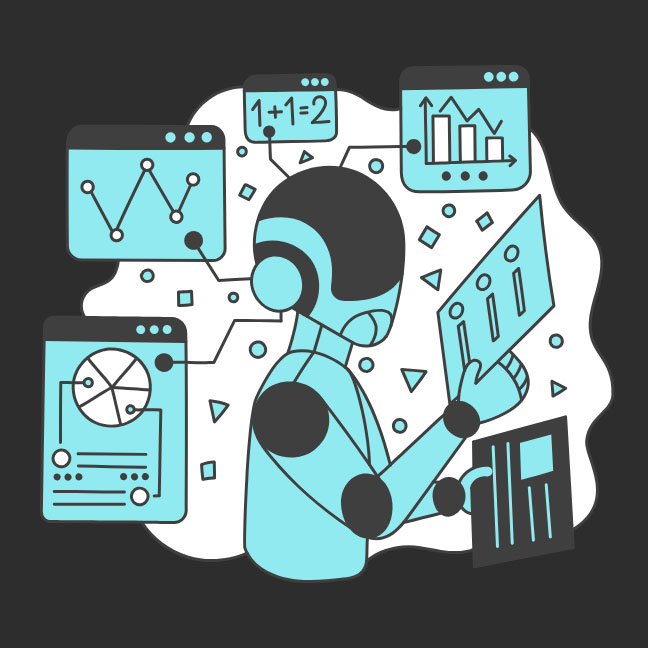Artificial Intelligence, zBlog
AI in Logistics: How Artificial Intelligence Is Reshaping the Supply Chain
trantorindia | Updated: July 24, 2025
The logistics industry stands at a crossroads. Faced with the rapid rise of e-commerce, global supply chain disruptions, increasing customer expectations, and mounting operational costs, traditional logistics systems are being pushed to their limits. The answer to these challenges? Artificial Intelligence (AI).
AI in logistics is no longer a futuristic concept—it’s a strategic imperative. From autonomous delivery vehicles and robotic fulfillment centers to AI-driven route optimization and predictive demand planning, logistics is undergoing a transformation. This comprehensive guide explores how AI is revolutionizing logistics, the technologies powering this shift, key applications, real-world success stories, and how businesses can get started.
What Is AI in Logistics?
AI in logistics refers to the use of artificial intelligence technologies—including machine learning, natural language processing (NLP), computer vision, digital twins, and robotics—to automate, optimize, and transform logistics operations across the entire supply chain.
Technologies Driving AI in Logistics:
- Machine Learning (ML): Analyzes large datasets to predict demand, optimize routes, and identify bottlenecks.
- Computer Vision (CV): Powers automated inspection, damage detection, and warehouse navigation.
- Natural Language Processing (NLP): Automates customer service and internal communication.
- Robotic Process Automation (RPA): Handles repetitive tasks like invoice processing and shipment tracking.
- Generative AI & LLMs: Create dynamic routing suggestions and simulate future scenarios.
- Digital Twins: Create real-time virtual models of logistics systems for predictive analysis.
Why AI in Logistics Matters in 2026 and Beyond
Key Drivers:
- E-Commerce Explosion: The U.S. e-commerce market is projected to hit $1.7 trillion by 2026.
- Last-Mile Complexity: Last-mile delivery accounts for over 41% of total logistics costs.
- Labor Shortages: Automation fills gaps in warehousing, trucking, and customer service.
- Supply Chain Volatility: AI helps businesses stay agile amidst disruptions like pandemics, weather, and geopolitical events.
Top Benefits of AI in Logistics
Real-World Use Cases of AI in Logistics
1. AI-Powered Route Optimization
- UPS’ ORION system saved 10 million gallons of fuel annually by using AI to optimize delivery routes.
- Uber Freight uses machine learning to match freight loads with carriers efficiently.
2. Predictive Demand Forecasting
- Amazon uses AI models to anticipate what products will be needed in which regions, reducing excess inventory and warehouse costs.
- Oracle SCM Cloud uses ML to enable predictive demand and shipment planning.
3. Warehouse Robotics and Automation
- Amazon Robotics: Over 750,000 mobile robots operate in Amazon fulfillment centers.
- Covariant AI: Offers vision-powered robots for picking, sorting, and packing.
4. Autonomous Vehicles and Drones
- Inceptio Technology: Piloting L3 and L4 autonomous trucks in China and the U.S.
- Wing (Google subsidiary): Drones delivering retail goods with AI-guided precision.
5. AI-Driven Vehicle Inspections
- UVeye partnered with Amazon to use computer vision to inspect delivery vehicles in seconds.
6. Digital Twins for Urban Logistics
- Logistics companies are using digital replicas of supply chains to model, simulate, and optimize routing and warehouse layouts in real time.
AI Logistics Tools and Platforms (2025–2026)
Strategic Roadmap: Implementing AI in Your Logistics Operation
Step 1: Identify Strategic Pain Points
- Last-mile inefficiencies?
- Delays in inventory turnover?
- High human error in documentation?
Step 2: Start with Pilot Projects
- Use AI chatbots for shipment queries.
- Apply ML to optimize a single warehouse’s layout.
Step 3: Build the Right Data Infrastructure
- Consolidate IoT sensor data.
- Clean legacy datasets for ML models.
Step 4: Partner with AI Experts
- Work with platforms like Trantor to integrate end-to-end systems.
Step 5: Measure & Scale
- Define KPIs: on-time delivery rate, fuel savings, lead times.
- Scale across geographies or functions.
Challenges and How to Overcome Them
Industry Statistics Worth Knowing
- AI in logistics market size projected to reach $23.3B by 2030, growing at 20.2% CAGR (Allied Market Research)
- AI has reduced fulfillment center costs by up to 25% (Amazon Robotics)
- 10–15% fewer empty miles using AI load matching (Uber Freight)
- 80% reduction in support queries using AI chatbots in B2B logistics (McKinsey)
FAQs: AI in Logistics (Featured Snippet Optimized)
What is AI in logistics?
AI in logistics refers to using artificial intelligence to automate and optimize supply chain processes, including routing, warehousing, demand forecasting, and delivery.
How does AI reduce logistics costs?
AI reduces costs by optimizing delivery routes, minimizing fuel usage, automating labor-intensive tasks, and improving asset utilization.
Is AI used in last-mile delivery?
Yes. AI powers route optimization, dynamic re-routing, and autonomous delivery via drones and self-driving trucks.
What’s the role of AI in warehouse management?
AI drives robotics, inventory forecasting, bin packing optimization, and real-time shelf scanning via computer vision.
Are there risks to adopting AI in logistics?
Common challenges include data integration, regulatory compliance, workforce adaptation, and upfront costs—but these can be mitigated with the right strategy and partners.
Final Thoughts: The Future of AI in Logistics
As the logistics industry navigates a future defined by complexity and demand volatility, AI will be the linchpin of scalable, intelligent, and resilient supply chains. Businesses that embrace AI in logistics today will gain not just operational efficiency, but a long-term competitive advantage.
Why Trantor is Your AI Logistics Transformation Partner
At Trantor, we help global enterprises unlock the full potential of AI in logistics. Our expertise spans:
- Custom AI development: From predictive models to robotic process automation
- Systems integration: Seamlessly embedding AI into your ERP and SCM workflows
- Digital twin solutions: Real-time modeling and simulation for agile operations
- AI strategy and governance: Ensuring compliance, explainability, and scalability



